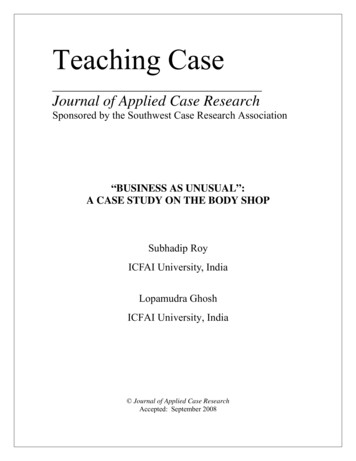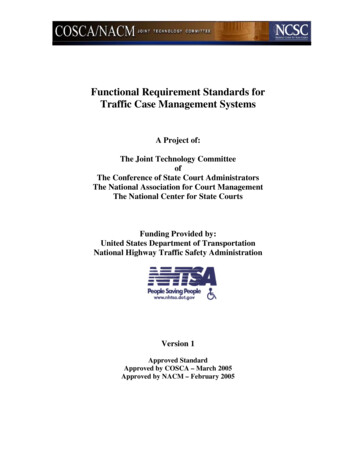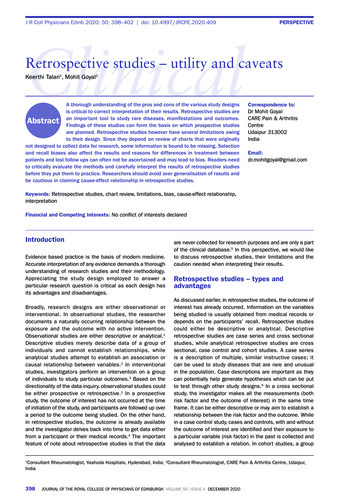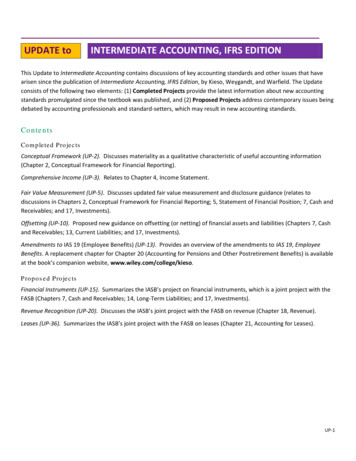
Transcription
Teaching CaseJournal of Applied Case ResearchSponsored by the Southwest Case Research Association“BUSINESS AS UNUSUAL”:A CASE STUDY ON THE BODY SHOPSubhadip RoyICFAI University, IndiaLopamudra GhoshICFAI University, India Journal of Applied Case ResearchAccepted: September 2008
2
“BUSINESS AS UNUSUAL 1 ”: A CASE STUDY ON THE BODY SHOP“The business has existed for one reason only – to allow us to use our success to act as aforce of change, to continue the education and consciousness-raising of our staff, to assistdevelopment in the Third World and above all, to help protect the environment. What weare trying to do is to create a new business paradigm, simply showing that business canhave a human face and a social conscience”.- Anita Roddick (1991) 2ANITA RODDICK STEPPED DOWN AS THE BODY SHOP CHAIRPERSONFebruary 2002, the founder of one of the biggest cosmetics companies in the world, AnitaRoddick (Anita) stepped down as the chairperson of the Body Shop along with husbandGordon Roddick (Gordon), who was a co-chair along with her. A number ofcontroversies in the mid and end 1990’s had badly affected the company’s image asdoing “business with a human face” as opined by Anita in the quote given above. Periodsof losses, coupled with poorly motivated shareholders, de-motivated franchisees,unsuccessful restructuring attempts and public propaganda against the company wasproving to be too strong for the company to cope up. Thus, the decision of Anita andGordon came up after several unsuccessful attempts to find a buyer for the firm.However, they still maintained control over more than 50% of the company’s votingrights along with Ian McGlinn, a friend of the Roddick’s and an early investor in thecompany. Around the same time, the then CEO Patrick Gournay, (who actually ascendedthe throne in 1998 when Anita stepped down as the CEO) resigned and was replaced byPeter Saunders, who was a former director of the North American operations of thecompany. Adrian Bellamy, the former CEO of the North American operations of thecompany, took over as executive chairman and assured that he would try to improve therelationships of the company with its 1200 franchisees around the world. The Roddicks,however, were retained as non executive directors on the company's board. AnitaRoddick continued to support the company as a consultant primarily responsible forfinding new ingredients to be used in Body Shop products. Anita was quoted as saying,“Being a non-exec is going to be much more fun for me because you can be much more atyrant.” 3The Body Shop was the vision of a lady Anita Roddick which evolved from a smalloutlet at Brighton in South England to a company having a global presence in more than50 countries and more than 2000 outlets (mostly franchises). The founder, Anita Roddickhad championed social causes and had fought multinational mammoths like Shell andExxon-Mobil (Refer to Appendix IX). The main reasons behind the success of thecompany were protesting against the testing on animals, campaigns against human rightsabuse, environmental protection and socially uplifting activities. In end 1990’s The BodyShop was voted the second most trusted brand in U.K. by a survey conducted byInterbrand. The founder Anita, as she was popularly known, had received numerousawards including the Dame Commander of the British Empire (DBE) (Refer to AppendixIX) in 2003. (Refer to Appendix VI for a list of awards won by Anita Roddick) The3
company which became popular among the consumers for its social activities was nolonger focused on the “ethical business” aspect for generating revenues, a factemphasized in the mission statement of the company. (Refer to Appendix I). Several newpolicies were implemented such as use of advertisements as a marketing tool which wasnot practiced at all during the reign of Anita. Though these were not fully acceptable tothe founder and mentor Anita, the then management had no choice. But before going intothe issues and challenges before the company, one needs to look into the past to find outhow the company came into being and became popular among the consumers.BACKGROUNDBack in the year 1976, Anita Roddick founded The Body Shop out of loneliness in onehand and to earn a living on the other. The first Body Shop outlet was established in asmall store in Brighton, South England in March 27th. The essence of the products wasthat it was made of natural ingredients. The customers found the products very uniqueand as the sole employee of the shop, Anita was very apt in handling her clients. In 1977when Anita’s husband Gordon Roddick came back, he came up with an idea offranchising as a way to expand the company. Thus, the first Body Shop franchiseeopened up in Brussels in 1978. This was followed by opening up franchises in Canada(1980) and Australia (1983). The Body Shop took off and in the year 1984 it was decidedto make the Body Shop a Public Ltd. Company. The first community trade programs ofthe Body Shop were started around 1986 in India. By the early 1990’s Body Shop was awell spread company all over the world. In 1994, Body Shop came up with its directselling division known as the Body Shop at Home. In the year 1995, the website of BodyShop was launched on the internet in order to keep pace with the IT revolution. The USoperations of Body Shop were sold to Bellamy Retail Group in 1999 which wasrepurchased back in 2001. In 2002, Anita Roddick stepped down as the Co-chairpersonof the Body Shop International PLC but she remained back as non-executive director. Inthe year 2004, the Body Shop International through its two wholly owned subsidiaries,the Body Shop Canada Ltd. and the Bath-Na-Bodhaige of U.S., acquired operations of itshead franchisee in Canada. The Body Shop with its innovative products containinghitherto unknown ingredients such as Aloe Vera, Jojoba Oil, and Cocoa Butter (Refer toAppendix IX) remained very popular among consumers all over the world till date.THE BUSINESS PHILOSOPHY OF THE BODY SHOPThe business philosophy of the Body Shop was evident from its mission statement. Themission statement itself signified that the company wanted to do something other thanjust selling cosmetic items. The values of the company were also evident from the tradingcharter of the Body Shop. (Refer to Appendix IV).Policies, Programs & Campaigns: The environmental campaigns of the Body Shopstarted as early as 1985 when the Body Shop entered into an alliance with Greenpeace topromote “Save the Whales” campaign. Throughout the entire journey of the Body Shopas a corporation, Anita had participated into campaigns such as protecting habitats of theOgoni people in Nigeria to fighting for human rights and against the World Trade4
Organization (WTO). She flew down to Seattle on November 1999, a few days before thethird ministerial conference of the WTO was being held. There, she campaigned against aglobal trade system she condemned as "unjust and unsustainable". In her words, theWTO was more obsessed with profits and in effect was neglecting issues of humanwelfare. In her speech, Anita said that the WTO was "blind to the injustice of the pursuitof profits at the expense of people. By default the WTO is a world government, but it is ablind government. It looks at the measurement of money, but it can't see anything else.” 4The ecological and social viewpoint came out from the core values of the company.(Refer to Appendix II). The chief activities of the Body Shop which identified it as acompany standing out as an example of ethical business are given as follows.Trade not Aid Program: The “Trade not Aid” program was started by the Body Shop in1987 to help the people of the Third World countries through self sustenance programs.The most popular among those programs was the production of the Brazil nut oil by theKayapo Indians (Refer to Appendix IX) of the Amazon basin in Brazil. This particularprogram was started sometime in 1991. The body Shop began working with the KayapoIndians to harvest the Brazil nut oil which was used in one of the best selling products ofthe Body Shop, the Brazil nut hair conditioning. Similar projects were taken up in variousother parts of the world such as New Mexico where the Pueblo Indians were associatedwith providing the Body Shop with Blue Corn.The Body Shop Foundation: The Body Shop Foundation was established in 1990 by theDirectors, employees, national and international franchisees to collect funds from theemployees as well as customers leading to creation of a fund that would support smallorganizations at the grass root level in the areas of human rights and ecologicalprotection. Till 2005, the Body Shop had donated over 5 million in grants and gift-inkind support thereby assisting the work of various organizations. The most important ofthe projects was the “Brazilian Healthcare Project” aimed at providing healthcare andeducation to local tribes in Brazil. The other notable projects were, “Children on theEdge” which aimed at alleviation of the suffering of orphan children in Romania, Kosovoand East Timor, “Protect the Child” aimed to bring an end to worldwide children abuse.Political Involvement: Throughout the history of The Body Shop, the company hadinvolved itself into activities which had ultimately led the company into clashes withpolitical factions. For example, around early 1990’s the Body Shop started a protestagainst the oil multinational Shell which had destroyed the natural habitats of the Ogonitribesmen in Nigeria. Though initially eight Ogoni tribesmen including theirspokesperson were executed by the Nigerian Government, 19 others were released by thegovernment as a result of the campaign. In 1997 after four years of the campaign, Shellissued an operating charter which declared the commitment of the company towardshuman rights and sustainable development. In September 2001, the Body Shop andGreenpeace joined hands with other organizations to protest against Exxon Mobil withcharges of global warming. In the same year, Anita Roddick tried to raise her voiceagainst the myths of globalization and WTO.5
CRITICISM AND CHALLENGESIn spite of the socially responsible activities by the Body Shop, the company was accusedwith a number of charges in the period between 1994 and 2000. The particular issues inwhich the Body Shop was challenged included its claims of natural ingredients,environmental protection; trade not aid program, animal testing, and charity issues.Natural Products: While the Body Shop claimed its products to contain naturalingredients only, it was found out that many of its products contained chemicals wherethe source was not mentioned. This implied that those ingredients were made in thelaboratories. Beside this there were reports of contaminated products supplies to theconsumers. In the year 1993, a batch of 151 bottles of contaminated Banana shampoowere sold to the consumers in the US, as stated in the report of the Food and DrugAdministration (FDA) USA (Refer to Appendix IX). However, the companyrepresentatives in the Body Shop replied to this incident by saying that the incident was aresult of shifting of operations from New Jersey to North Carolina. Still the question thatremained was that of claims regarding natural ingredients. Whereas companies thatmarketed cosmetic products made from natural ingredients mentioned the originalsources on the package, the body shop did not do so. For example, the Aloe Hair Gellabel read “Water, Rosewater, SD Alcohol 40-B, Aloe Vera Gel, PVP (setting agent),Triethanolamine, PEG-75 Lanoline, Propylene Glycol, Carbomer 940, Phenoxyethanol,Polysorbate 20, Methylparaben, Benzophenone-4, Disodium EDTA, SodiumDehydroacetate, Propylparaben, Fragrance, FD&C Yellow No. 5, FD&C Blue No. 1.” 5The organic or natural sources were not mentioned.Environmental Claims: While the Body Shop claimed to be a company which activelyparticipated in environmental protection, investigating reporters like Jon Entine hadblamed the company for making misleading claims. David Brooke, the Body Shopformer manager of environmental affairs had dismissed the company’s environmentalclaims as window dressing. However, the fact still remained that the Body Shop had agood record of environmental audit and disclosure. The Body Shop was a signatory of theCERES principles, an environmental code of conduct that was created byenvironmentalists and social investors. Apart from that, the Body Shop was one of thefew companies to have an efficient environment management system and environmentaudit which followed the voluntary European Union Eco Management and AuditRegulation.Trade not Aid: Again critics like Jon Entine had highly criticized the trade not aidprogram taken up by the Body Shop. Terence Turner, an anthropologist at the Universityof Chicago claimed that the Kayapo Indians made their bulk income from selling loggingand mining concessions on their lands, which were actually the activities that the BodyShop claimed to have protected. Turner also observed that the income generated throughthe trade not aid program by the Kayapos was insignificant compared to their baseincome. However, it was found out that the Kayapos themselves did not want the BodyShop to pull out. In fact, some villages wanted the Body Shop to establish projects there.6
Animal Testing: Though the Body Shop was against the testing of products on animals,it was found out according to an internal memo of the company in 1992 that almost 50%of the company’s products were tested on animals. One fierce attack came from a Britishtelevision program entitled “Body Search” which accused The Body Shop of misleadingcustomers with its “Against Animal Testing” product label. The Body Shop’s policy,designed as an incentive for companies to eliminate their animal testing, requiredrejecting all ingredients that had been tested on animals in the previous five years. TheTV program, however, charged the company with using ingredients that had been testedon animals. The Body Shop brought a suit against the television station 1993 and won 276,000 in damages. Although the company won the suit, the battle had focusedattention on the Body Shop’s ethical record and inspired additional criticism.Charity Issues: The reputation of the Body Shop for charitable giving had been an issueamong the critics. The critics claim that, while responsible charitable organizations suchas Patagonia and Ben & Jerry’s contribute 10% and 7.5% of its pre-tax profits for charity,the Body Shop is contributing around 3% of its pre-tax profits. However, the figures donot take into account the voluntary activities undertaken by the employees of the BodyShop and the contributions made by the customers. Different fund raiser activities such assale of red ribbons during World Aids Day and collection of funds from the customers in‘Violence Against Women’ campaigns also contributed to the charity activities conductedby the company.RESTRUCTURING THE COMPANYAll these negative propaganda proved to be very hard for the Body Shop which lost itsground somewhat in the period from 1995 to 1997. (Refer to Appendix V for thefinancial figures of The Body Shop) However the pressures were countered by the BodyShop through some restructuring measures around late 1990’s. The mounting financialand competitive pressures forced the company to undergo re-structuring in 1998 whenAnita Roddick stepped down from her position as CEO and invited Patrick Gournay, whowas then working with the French food giant Danone to turn around the company. Criticsbelieved that the emphasis on social issues rather than business was actually hurting thecompany. However, the founder, Anita Roddick, refused to accept this fact. Since 1998,Anita had devoted a lot of her time on the Company. She had traveled all over the worldevery year for sourcing new products and setting up new community trade programs.Anita said she saw herself as guardian of the Body Shop’s “DNA” which was the strongsocial, ethical and environmental stance of the company. She said, “That’s what sets usapart. If you took that away from us, we’d be a dime-a-dozen cosmetics company.” 6After his ascent to power, Patrick Gournay immediately implemented a retrenchment of300 staff aimed at reduction of cost. In spite of the management overhaul, the companyran into losses in the year 2000. Some of the issues yet to be addressed were that ofinventory accumulation and excessive new product launches. The inventory managementproblem was an outcome of a move by the company. In the early 1990’s the Body Shopused to operate with the franchisee model. But by the late 1990’s the company started tobuy back the franchised outlets and the franchisee was offered a job as an employee inthe parent company. This created a problem with the franchisees that were not willing to7
sell off their business. The Body Shop retaliated by restricting the supply of its keyproducts to the franchisee. This had a two way effect on the parent company. On onehand inventory started to accumulate and on the other hand the company lost revenue andcustomers. The percentage of franchised outlets dropped from 75% in 1993 to around10% in 2000. Coupled with that, almost 100 new products were launched in the 19992000 period, which only aggravated the problem. In an interview, Mr. Gournay assuredthat company was taking action to address all the relevant issues. “The Body Shop isrestoring margins on last year's products by reducing product costs while also ensuringthat current year launches maintain its average margin. The company is also transferringresponsibility for inventory management to its regional teams and is this yearimplementing a much smaller number of new product launches while developing itsheritage ranges. For the current year, we are anticipating a reasonable improvement inprofit as the benefits of our actions begin to feed through to our results. Overall, we havemade significant progress with implementing the structural changes that were needed torefocus the company on its retailing activities." 7 In April 2001, the Body Shop emergedwith a brand-new store format and introduced a new skin care line, a fragrance collectionand a new color story for its “Colourings” cosmetics line. It also undertook arestructuring of the corporate logo and came up with a new one. The increasingcompetition forced the company to relax its stance against mass advertising when in July2001; the company used an outside advertising agency for the first time in the history ofthe company. In the same month, the partner and CEO of North American operations ofthe Body Shop, Adrian Bellamy, decided to sell back his stake in the US business toAnita and Gordon Roddick. Bellamy, who sold his stake for 7.9M in shares and cash,opined that the company “should put profits before passion” 8 and that it needed to adaptits hallmark social crusades, which he thought were not being able to move with thetimes. Things culminated with the step down of Anita and husband Gordon co-chairs ofthe company. Anita started to write books and devoted more of her time to launchcrusades for social and environmental issues.WHAT LIES AHEADThe new management under Adrian Bellamy met with a lot of difficulties in the early2000’s. After suffering from the problems of stiff competition and mismanagement ofstocks, the body shop was not in good position in the early 2005. Matters went to such anextent that the founders Anita and Gordon Roddick sold 7.4 m of their shares at 185p inFebruary, 2005. This was followed by sell-off of 10 m stake by Ronald-de-Waal, a nonexecutive director, in March 2005. The company took on a massive repositioning activityin early 2005. The company tried to make some drastic changes in their product offeringto target the up-market consumers. (Refer to Appendix VII for the Product Categories ofThe Body Shop) According to Andy King (King), the global marketing director of thecompany, “We repositioned the brand to carve out a differentiated position in a crowdedcosmetics market”. 9 King described the new brand image as “masstige” i.e. somewherebetween mass market and prestige. Changes had taken place in many aspects. The shopinteriors had been changed from the traditional dark floors and walls to neutral tiles andhemp-coated backlit screens. (Refer to Appendix VIII for new store décor of the BodyShop outlets) Colorful and bulging shelves had been replaced with attractive glass8
counters. Even the black-topped bottles, which used to come in three different sizes(fitting every pocket), had been replaced with 'Boston round' containers with white capswhich came only in large sizes. The new 'invent your scent' perfume counter andluxurious ‘Spa Wisdom’ range, introduced in March, had been designed to tempt thosecustomers who would usually shop at the counters of a department store. The 'love yourbody' loyalty scheme, which offered a 10 percent discount for customers buying a 5loyalty card, (Refer to Appendix III) had been successful in attracting customers. Theprogram was launched in the UK in 2004 after a successful five-year run in the US, andhad amassed half a million members by mid 2005. The global cosmetics and toiletriesindustry which was growing at a healthy rate from 2000 also acted as a catalyst in thisprocess. (Refer to Appendix IX) The good times seemed to be back with the companywith The Body Shop winning the Royal Society for the Prevention of Cruelty to Animals(RSPCA) Award (Refer to Appendix IX) in 2005 for promoting and practicing animalwelfare. The RSPCA award was given to corporations employing best practices in termsof treatment to animals in the cosmetics, fashion and food industries. The Body Shop wasthe winner in the Cosmetics Category. The awards were given out after judging thepolicies of the nominees in the respective areas: Product testing on animals. Product Ingredient testing on animals. Labeling.Meanwhile, Anita, the co-founder and the one time chief force behind the company, wasstill associated with the company as a consultant (other than being a non-executivedirector) for 80 days a year, and gave her advice on product marketing and the ethicaldimensions of the company. However, the question that can be raised is ‘how ethical isthe Body Shop today?’ since its new product offering was going against the famousmotto of 'reduce, recycle, reuse' of the company in the 1970’s and 1980’s. Though thestaffs still insist that the company's values were maintained as it was and cite the exampleof one of their new products in the hair care range, where honey was sourced from 6,000organic beekeepers in Zambia. With a global presence in 53 countries, Body Shop had tostrike a balance between the variable demands of global consumers. Though the questionof ethical marketing was an important deciding factor for the consumers in Europe andAmerica, but still the Body Shop was considered to be a prestige brand in the MiddleEast and Asia. The fact that the Middle East and Asia together comprise of more than25% of the global cosmetics and toiletries market is supposed to provide the leverage thebrand needs. (Refer to Appendix IX) However, time would tell whether the new strategyof the company would bring in new laurels or brickbats.9
APPENDIX ITHE MISSION STATEMENT OF THE BODY SHOP To dedicate our business to the pursuit of social and environmental change. To creatively balance the financial and human needs of our stakeholders: employees,customers, franchisees, suppliers and shareholders. To courageously ensure that our business is ecologically sustainable: meeting theneeds of the present without compromising the future. To meaningfully contribute to local, national and international communities inwhich we trade, by adopting a code of conduct which ensures care, honesty, fairnessand respect. To passionately campaign for the protection of the environment, human and civilrights, and against animal testing within the cosmetics and toiletries industry. To tirelessly work to narrow the gap between principle and practice, whilst makingfun, passion and care part of our daily lives.Source: about reason.jsp10
APPENDIX IITHE CORE VALUES OF THE BODY SHOPWe consider testing products or ingredients on animals to be morally and scientificallyindefensible.We support small producer communities around the world who supply us withaccessories and natural ingredients.We know that you're unique, and we'll always treat you like an individual. We likeyou just the way you are.We believe that it is the responsibility of every individual to actively support thosewho have human rights denied to them.We believe that a business has the responsibility to protect the environment in which itoperates, locally and globally.Source: values.jspAPPENDIX IIITHE LOVE YOUR BODY LOYALTY CARDSource: The Body Shop Interim Results 200511
APPENDIX IVTHE BODY SHOP TRADING CHARTERThe way we trade creates profits with principles.We aim to achieve commercial success by meeting our customers' needs through the provision of highquality, good value products with exceptional service and relevant information which enables customers tomake informed and responsible choices. Our trading relationships of every kind - with customers,franchisees and suppliers - will be commercially viable, mutually beneficial and based on trust andrespect.Our trading principles reflect our core values.We aim to ensure that human and civil rights, as set out in the Universal Declaration of Human Rights, arerespected throughout our business activities. We will establish a framework based on this declaration toinclude criteria for workers' rights embracing a safe, healthy working environment, fair wages, nodiscrimination on the basis of race, creed, gender or sexual orientation, or physical coercion of any kind.We will support long term, sustainable relationships with communities in need. We will pay specialattention to those minority groups, women and disadvantaged peoples who are socially and economicallymarginalized.We will use environmentally sustainable resources wherever technically and economically viable. Ourpurchasing will be based on a system of screening and investigation of the ecological credentials of ourfinished products, ingredients, packaging and suppliers.We will promote animal protection throughout our business activities. We are against animal testing in thecosmetics and toiletries industry. We will not test ingredients or products on animals, nor will wecommission others to do so on our behalf. We will use our purchasing power to stop suppliers animaltesting.We will institute appropriate monitoring, auditing and disclosure mechanisms to ensure ouraccountability and demonstrate our compliance with these principles.Source: trading.jsp12
APPENDIX VSUMMARY OF FINANCIAL DATA OFTHE BODY SHOP, 94YearItemsTurnover ( m)OperatingProfit ( m)PBT ( m)Earnings PerShare (p)Net CurrentAssets ( m)Number ofStores419.0 381.1 378.2 379.6 374.1 330.1 303.7 293.1 270.8 256.5 219.7 195.436.2 30.3 24.3 15.2 18.2 33.0 20.1 38.1 31.9 33.7 34.5 1968195418301730166315941491137312101053Source: The Body Shop International Plc. Annual Reports 2005, 1999 and 1998.13
APPENDIX VISELECTED AWARDS WON BY ANITA RODDICK1984 - Veuve Clicquot Business Woman of the Year1988 - OBE - Order of the British Empire1991 - Center for World Development Education's World Vision Award, USA1993 - Banksia Foundation's Australia Environmental Award1993 - Mexican Environmental Achiever Award1993 - National Audubon Society Medal, USA1994 - Botwinick Prize in Business Ethics, USA1994 - University of Michigan's Annual Business Leadership Award, USA1995 - Women's Business Development Center's First Annual Woman PowerAward, USA1996 - Women's Center's Leadership Award, USA1996 - The Gleitsman Foundation's Award of Achievement, USA1997 - United Nations Environment Programme (UNEP), Honouree, Eyes on theEnvironment1999 - British Environment & Media Award1999 - Chief Wiper-Away of Ogoni Tears, Movement for the Survival of the OgoniPeople, Nigeria2001 - International Peace Prayer Day Organisation's Woman of Peace2003 - DBE (Dame Commander of the British Empire)Source: http://www.anitaroddick.com/aboutanita.php14
APPENDIX VIIPRODUCT LINES AND CATEGORIES OFFERED BY THE BODY bs &MasksEye CareSun CareTonersLotionsHand LipsMakeupToolsEyesFoot CareSun CareLipsScrubsSource: IESEau de ParfumShampooEau de ToiletteConditionerPerfume OilsTreatmentShaving& FaceHair geBody SpraysStylingProductsFragranceBags & eFragrancesInvent YourScentBath gLotionsHair BrushesMake-Up ToolsBooksGift Ideas
APPENDIX VIIIA BODY SHOP OUTLET IN THE LATE 1990’sA BODY SHOP OULET IN 2005Source: Reports from www.thebodyshopinternational.com
APPENDIX IXBrief on the Cosmetics and Toiletries Industry 10The global cosmetics and toiletries industry is valued at US 254 billion in terms ofrevenue in 2005. It consists of the following product categories: bath and shower,fragrance, oral hygiene, skin care, men’s grooming products, color cosmetics, hair care,depilatories, deodorants and body care. World sales of cosmetics and toiletries sales wereUS 170 billion in 1997 whic
The Body Shop took off and in the year 1984 it was decided to make the Body Shop a Public Ltd. Company. The first community trade programs of the Body Shop were started around 1986 in India. By the early 1990's Body Shop was a well spread company all over the world. In 1994, Body Shop came up with its direct











